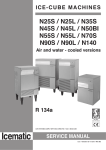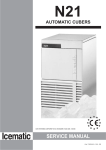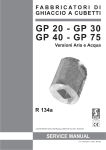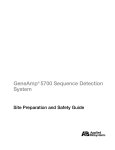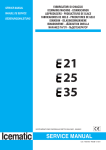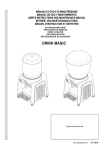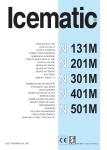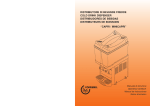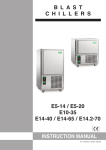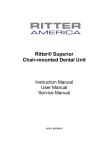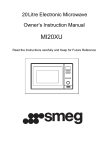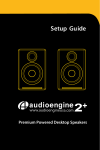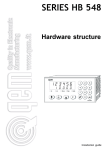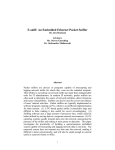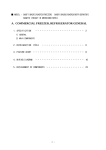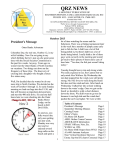Download Ghiaccio aria-Service-000-GB
Transcript
ICE-CUBE MACHINES N25 - N35 - N45 - N55 N50BI - N70 - N90 - N140 Air and water - cooled versions R 134a OUR MACHINES CONFORM TO EC STANDARD 73/23 CEE - 89/336 SERVICE MANUAL Cod. 71503026/0 GB - 09/2000 - Rev. 000 Icematic ® ISTRUZIONI D’USO HOW TO USE IT NOTICE D’EMPLOI GEBRAUCHSANWEISUNG GEBRUIKSAANWIJZING ISTRUCCIONES PARA EL USO MANUAL DE USO BRUKSANVISNING BRUKSANVISNING BRUGSANVISNING KÄTTÖHJE Ο∆ΗΓΙΕΣ ΧΡΗΣΕΩΣ HOW TO USE IT FABBRICATORI DI GHIACCIO ICEMAKING MACHINES EISMASCHINEN PRODUCTEURS DE GLACE IJSPRODUCERS FABRICADORES DE HIELO PRODUTORES DE GELO ISMASKINERNE ISMASKIN ISLAGING SMASKINENE JÄÄKUUTIOK ONEILLA ΜΗΧΑΝΕΣ ΝΑΡΑΓΩΓΗΣ ΜΑΓΟΥ ICEMAKING MACHINES cod. 71503418/0 Rev.005 N25 S N25 L N35 S N45 S N45 L N55 S N55 L N70 S N90 S N90 L 5 1 8 9 2 5 10 3 6 11 4 7 12 19 16 13 17 20 14 21 18 A B C 15 22 ATTENTION !!! LES OPÉRATIONS SUIVANTES AINSI QUE CELLES MISES EN ÉVIDENCE PAR LE SYMBOLE SUR LE COTÉ SONT STRICTEMENT DÉFENDUES A TOUS CEUX QUI UTILISENT LA MACHINE. CES OPÉRATIONS NE PEUVENT ÊTRE EFFECTUÉES QUE PAR UN INSTALLATEUR DIPLOMÉ. 1. RACCORDEMENTS ÉLECTRIQUES 2. RACCORDEMENTS À L’ALIMENTATION D’EAU 3. INSTALLATION DE L’APPAREIL 4. ESSAI DE LA MACHINE 5. INTERVENTIONS DE RÉPARATION DE TOUS COMPOSANTS ET ORGANES DE LA MACHINE 6. DÉMONTAGE DE LA MACHINE OU DES COMPOSANTS 7. INTERVENTIONS DE RÉGULATION ET CALIBRAGE 8. NETTOYAGE ET ENTRETIEN DES COMPOSANTS: ÉLECTRIQUES, ÉLECTRONIQUES, MÉCANIQUES, FRIGORIFIQUES. 10 F B L MISE EN MARCHE Avant de mettre le producteur de glace en marche, effectuer les opérations suivantes: 1) regarder les dessins. a) retirer le couvercle après avoir enlevé les deux vis de fixation. b) débloquer le motoréducteur, les palettes et le flotteur en enlevent les arrêts 1, 2, 3, placés à l’usine pour immobiliser les pièces pendant le transport (fig. n° 16). Dans les versions avec refroidissement à eau, relier aussi à l’écoulement le deuxième raccord qui évaque l’eau provenant du condenseur. Pour un débit parfait de l’eau de l’appareil, prévoir une pente minimum de 3% de la tuyauterie en contrôlant que cette dernière ne subisse pas d’engorgements ou d’étranglement. Il est opportun que la tuyauterie déverse dans un siphon ouvert (fig. n° 15). 2) Avant le branchement électique s’assurer que le voltage du secteur corresponde à celui indiqué sur la plaque placée sur le socle de la machine. La variation de tension maximum tolérée est de ± 10% par rapportà la valeur nominale. Prévoir un circuit d’alimentation à la machine, avec son propre interrupteur général bipolaire ayant une ouverture des contacts d’au moins 3 mm., avec un fusible ou protection automatique et une prise électriqueavec mise à la terre. Respecter l’ampérage indiqué sur la plaque signalétique (fig. n° 19). La prise doit etre abilement faisable. Pour allumer et éteindre l'appareil, il suffit de presser l'interrupteur ON/OFF. Le bouton de RESET existe seulement sur les modèles avec refroidissement à eau. Dans le cas où la lampe témoin d'alarme soit allumée, il faut presser le bouton de RESET placé à l'intérieur du volet (fig. n° 22). La lampe témoin d'alarme s'allume s'il manque de l'eau pour le refroidissement du condensateur ou à cause d'un problème de condensation Fig. 22 - interrupteur ON/OFF (A) - Bouton de RESET (B) - Lampe Témoin d'alarme (C). INFORMATIONS GENERALES Les producteurs de glace ont reçu l’approbation VDE et GS dont les symbols sont appliqués sur l’emballage, la plaque d’immatriculation et la carrosserie (fig. n° 13). NOS PRODUITS SUIVENT LA DIRECTIVE BASSE TENSION 73/23/CEE - 89/336/CEE ET REPORTENT DONC LA MARQUE SUR LA COUVERTURE DU LIVRET. INSTALLATION Avant de faire fonctionner le producteur de glace en cubes, exécuter les opérations suivantes: 1) Contrôler que l’appareil n’ait subi aucun dommage pendant le transport (fig. n° 1). 2) Extraire du dépôt tous les accessoires livrés avec la machine: tuyau d’alimentation, enveloppe de documentation, pieds (pour le modèle N30) et pelle à glace. 3) Nettoyer l’intérieur du dépot avec une éponge humidifiée d’eau tiède avec un peu de bicarbonate de soude; rincer avec de l’eau pure et essuyer avec soin. 4) Placer l’appareil à l’emplacement définitif en assurant que celui-ci soit à niveau (fig. n° 10). ATTENTION: Avant de choisir la pièce danslaquelle installer l’appareil, il est nécessaire de s’assurer que: a) la température ambiante ne descende pas audessous de 10°C et de ne dépasse pas les 40°C (fig. n° 7). b) la témperature de l’eau d’alimentation ne soit pas inférieure à 5°C et ne dépasse pas les 40°C. c) la pression de l’eau d’alimentation ne soit pas inférieur à 1 atmosphère et ne dépasse pas les 5 atm. Si la pression dépasse les 5 atm. il faut prévoir la pose d’un réducteur de pression sur l’alimentation d’eau de la machine (fig. n° 8). d) la machine soit éloignée des sources de chaleur et en position bien aérée (fig. n° 9). IL DOIT Y AVOIR DANS L’INSTALLATION ÉLECTRIQUE UN INTERRUPTEUR DIFFÉRENTIEL (DISPOSITIV DE SÉCURITÉ). 5) Effectuer les raccordements à l’alimentation d’eau avant ceux à l’électricité. 6) Relier le tuyau d’alimentation de 3/4 livré avec la machine, à l’alimentation d’eau froide potable. Pour des raisons d’utilité et de sécurité, il est conseillé de monter un robinet d’arrêt (que nous ne fournissons pas) (fig. n° 15: 1. interrupteur; 2. prise; 3. fiche; 4. alimentation d’eau; 5. robinet; 6. écoulement d’eau du condensateur: version refroidissement par eau; 7. écoulement d’eau du dépot; 8. écoulement d’eau avec siphon ouvert). 7) Monter sur le raccord d’évacuation d’eau de l’appareil un tuyau flexible en plastique ayant un diamètre intérieur de 20 mm. et une longeur permettant son raccordement à l’égoût (non supérieure à 1 metre de l’appareil (fig. n° 15). ATTENTION: Ne pas mettre l’appareil en fonction avant l’intervention du technicien (fig. n° 4). FONCTIONNEMENT Les machines à glace en cubes sont particulièrment compactes et peuvent donc facilement s’adapter à l’ameublement de n’importe quel local. Les cubes de glace se forment autour des tiges de l’evaporateur immergées dans un bac rempli d’eau agitée en permanence par des palettes tournantes. Le niveau de l’eau dans le bac est maintenu constant par un flotteur relié à un micro contact qui commande l’ouverture d’une électrovanne d’entrée d’eau. Lorsque que les cubes ont la dimension prévue ils touchent les palettes agitatrices et provoquent l’oscillation du motoréducteur. Ce dernier sollicite un micro contact qui, par l’intermédiaire d’un rélais, provoque en même temps: - l’envoi de gaz chaud à l’évaporateur par l’ouverture d’une électrovanne, qui cause le détachement graduel des cubes des tiges de lévaporateur. - le renversement du bac à eau relié à un motoréducteur par un levier. Dès que les cubes sont detachés, ils glissent sur une grille inclinée placée à l’intérieur du bac et tombent dans le dépôt qui se trouve en-dessous. L’eau qui reste dans le bac est recueillie dans un récipient situé sur une côté du dépôt et s’écoule vers une évacuation - Installer la machine dans une position telle que la ventilation du groupe frigorifique ne soit pas empêchée (seulement pour les machines refroidies par l’air) (fig. n° 11). - Ne pas installer la machines dans des locaux poussiéreux car un engorgement rapide du condensateur du groupe frigorifique peut se produire (seulement pour les machines refroidies par l’air) (fig. n° 20). Dans le cas où la machine est installée dans des zones où l’eau potable a un haut niveau de sels en solution, suivre les instructions du constructeur pour limiter l’inconvénient au minimum. - Pour éviter que la glace absorbe des odeurs et des saveurs mauvaises, ne pas conserver dans le récipient les aliments, les bouteilles et d’autres choses. - Pendant le fonctionnement normal, ne pas laisser ouverte la porte du récipient de la glace. 11 NETTOYAGE ET ENTRETIEN reliée à l’égoût. Apres environ une minute le bac revient automatiquement en position horizontale et se remplit d’eau jusqu’au niveau établi. Pendant ce temps, la vanne à gaz chaud se referme et le cycle de formation de la glace reprend normalement; le temps d’un cycle complet peut varier d’environ 15’ à 25’ en fonction de la température de l’eau et celle de la pièce. La quantité de glace dans la réserve est contrôlée par le bulbe du thermostat fixé sur une paroi; lorsque les cubes arrivent au niveu du bulbe l’appareil s’arrête automatiquement. Après quelques prélèvements de glace permettent de libérer le bulbe du contact avec les cubes, la machine reprendera sa production normale. NOTA: Toutes les opérations de nettoyage et entretien doivent être effectuées après avoir debranché l’alimentation électrique de la machine. NETTOYAGE DU CONDENSEUR A AIR L’accumulation progressive de poussière dans le condenseur provoque petit à petit une réduction du rendement frigorifique de l’appareil et donc de la production de glace. Il est donc conseillé d’inspecter fréquemment le condenseur situé sur la partie antérieure du producteur et de le nettoyer avec une brosse non métallique ou mieux encore avec un aspirateur. On accède au condenseur en enlevant la grille antérieure. NOTA: Après les prélèvements, libérer le bulbe de contrôle des éventuels résidus de glace pour permettre une reprise plus rapide de la production. NETTOYAGE DU FILTRE D’ENTREE D’EAU Fermer le robinet d’arrêt, débrancher le tube d’entrée d’eau et retirer avec une pince le filtre situé sur l’électrovanne d’entrée d’eau. Nettoyer le filtre avec un jet d’eau et le remettre en place. INFORMATIONS POUR LE SERVICE LES OPERATIONS SUIVANTES DOIVENT ÊTRE EFFECTUEES UNIQUEMENT PAR LE PERSONNEL QUALIFIE’ DU DISTRIBUTEUR ICEMATIC LOCAL (fig. n° 2). NETTOYAGE DE LA CARROSSERIE Nettoyer avec un tourchon légérement imbibé d’eau tiède. 1) Contrôler que le robinet d’alimentation d’eau soit ouvert, ensuite introduire la prise électrique de la machine à la prise de courant et enclencher l’interrupteur. La machine commence à fonctionner automatiquement (fig. n° 14) apres avoir pressè le bouton de demarrage ON/OFF (fig. n° 22). 2) Contrôler que l’eau arrive au bac, que le flotteur arrête le débit d’eau avant le débordement du bac et qu’il n’y ait pas de perte sur l’installation et les conduites d’eau. Le niveau normal de l’eau dans le bac se situe à 5 10 mm des bords. Le réglage du niveau de l’eau s’effectue en tournat le microflotteur dans la fente prévue à cet effet, après avoir désserré les vis de fixation (fig. n° 17). Ce réglage doit être effectué après avoir débranché le courant. 3) Vérifier qu’il n’y ait pas de vibrations anormales à cause de vis dessérées. 4) Dans le cas d’une intervention pour des pertes d’eau, de serragede vis ou autre chose, avant tout, arrêter toujours l’appareil. 5) Contrôler un cycle complet de production de glace. 6) Vérifier le bon fonctionnement du thermostat en appuyant un cube de glace sur le bulbe du thermostat à l’intérieur du réservoir, la machine devrait s’arrêter au bout d’une minute et repartir automatiquementpeu de temps après qu’il ait été enlevé. NETTOYAGE DU DEPOT Enlever la glace de la réserve. Nettoyer l’intérieur avec une éponge humidifiée d’eau tiède avec un peu de bicarbonate de soude; rincer avec de l’eau pure et essuyer avec soin. NETTOYAGE DU BAC A EAU ET DE L’EVAPORATEUR Mettre dans le bac une solution d’eau et d’acide citrique (200 gr. d’acide citrique pour un litre d’eau) et, avec un pinceau, nettoyer l’intérieur du bac et les tiges de l’évaporateur. Provoquer le renversement du bac en faisant fonctionner l’appareil, rincer abondamment avec de l’eau propre et répéter l’opérationtrois fois. Si l’appareil reste inutilisé pour des longues periodes: - désactiver la machine - enlever toute la glace du récipient - décharger complétement l’eau - exécuter un nettoyage soigné - laisser la porte du récipient légèrment ouverte. ATTENTION Si la machine est installée dans une localité à une altitude supérieure à 500 mt. au-dessus du niveau de la mer, il est nécessaire de procéder à un réglage différent du thermostat. En effet, celui-ci, à cause de la diminution de la pression baromètrique, devient moins sensible et l’appareil continue donc à fonctionner même si la réserve est pleine. On accède au thermostat en enlevant le couvercle du boîtier électrique; la vis de réglage (fig. n° 18) doit être visée dans le sens horaire pour augmenter la sensibilité du thermostat. Ne pouvant pas quantifier le tours de vis en relation avec l’altitude, car ils peuvent varier de thermostat à thermostat, nous conseillons de procéder au réglage en vérifiant qu’un cube de glace appuyé sur le bulbe du thermostat fasse arrêter l’appareil en une minute. BRANCHEMENT DE L'APPAREIL AU RÉSEAU ÉLECTRIQUE. Si le câble d'alimentation électrique de l'appareil est endommagé, le faire remplacer par un personnel qualifié de façon à prévenir tout rique pour les personnes. 7) Remonter le couvercle enlevé précédemment. 12 ICE MAKER SERVICE Place Stamp Here Affrancare Castel MAC SpA Via del Lavoro, 9 31033 Castelfranco Veneto (Treviso) Italy SERVICE NOTES - NOTS DE SERVICE - NOTE DI SERVIZIO DATE REF. Icematic Warranty Registration Card Cartolina di Registrazione Garanzia Fiche de Registration Garantie Garantie - Registrierung Karten Owner Name Nome del Cliente Nom du Client Name des Kundes Selling Agent Agente Venditore Agent Vendeur Verkauter Street Via Rue Strasse Street Via Rue Strasse City Città Ville Stadt City Città Ville Stadt Date of installation Data d’installazione Date d’installation Aufstellungsdatum Day Giorno Jour Tag Model Number Modello Numero Modèle numéro Modell Nr Serial N. Numero di serie Série numéro Seriennummer Month Mese Mois Monat Year Anno An Jahr (Factory use) Numero di serie Série numéro Seriennummer Note: Please return this card to factory for warranty protection. Proteggere la vostra macchina ritornando subito questo tagliando alla fabbrica. Retournez celle carte à l’Usine pour la protection de votre machine. Bitte schicken diese Karte an die Fabrik zurück, um ihre Machine zu schützen. Icematic Warranty Registration Card Cartolina di Registrazione Garanzia Fiche de Registration Garantie Garantie - Registrierung Karten ® Owner Name Nome del Cliente Nom du Client Name des Kundes Selling Agent Agente Venditore Agent Vendeur Verkauter Street Via Rue Strasse Street Via Rue Strasse City Città Ville Stadt City Città Ville Stadt Date of installation Data d’installazione Date d’installation Aufstellungsdatum Day Giorno Jour Tag Model Number Modello Numero Modèle numéro Modell Nr Serial N. Numero di serie Série numéro Seriennummer Month Mese Mois Monat Year Anno An Jahr (Factory use) Numero di serie Série numéro Seriennummer Note: Please return this card to factory for warranty protection. Proteggere la vostra macchina ritornando subito questo tagliando alla fabbrica. Retournez celle carte à l’Usine pour la protection de votre machine. Bitte schicken diese Karte an die Fabrik zurück, um ihre Machine zu schützen. Castel MAC SpA - 31033 CASTELFRANCO VENETO - Italy - TF (0423) 738.452 - 738.311 - TELEFAX (0423) 722811 cod. 71503418/0 Rev.005 ✂ ® GB INDEX GENERAL INFORMATION • Introduction ......................................................................................................................................................... • Unpacking ad inspection .................................................................................................................................... pag. 2 “ 2 • Locate and levelling ............................................................................................................................................ “ 3 • Water supply connections .................................................................................................................................. “ 3 • Electrical connections ......................................................................................................................................... “ 4 • Final check ......................................................................................................................................................... “ 4 • Operating instructions ........................................................................................................................................ “ 5 • Ice - forming cycle .............................................................................................................................................. “ 5 • Electrical and refrigeration systems ................................................................................................................... “ 6 • Machine main parts descriptions ........................................................................................................................ “ 7 • Trouble - shooting ............................................................................................................................................... “ 8 INSTALLATION OPERATION MAINTENANCE • Periodical maintenance and cleaning ................................................................................................................ “ 10 • Icemaker cleaning .............................................................................................................................................. “ 10 • Parts replacement procedures ........................................................................................................................... “ 10 TECHICAL DATA & WIRING DIAGRAMS Technical data ....................................................................................................................................................... “ 13 Wiring diagrams .................................................................................................................................................... “ 22 1 GB GENERAL INFORMATION A. INTRODUCTION This manual provides the specification and the step-bystep procedures for the installation, start-up and operation, maintenance and cleaning for the Icemakers. The machine cubers are quality designed, engineered and manufactured. Their ice making systems are thoroughly tested providing the utmost in flexibility to fit the needs of a particular user. This product qualifies for the following listings: These icemakers have been engineered to our own rigid sefety and performance standards. The VDE - SEV - GS seals signifity that it is listed with them and that it complies with the materials and manufacturing standard of them. These seals also signify that these icemaker models have been inspectors who reserve tha right to periodically examine production icemakers at the factory to assure continued compliance. NOTE. To retain the safety and performance built into this icemaker, it is important that installation and maintenance be conducted in the manner outlinde in this manual. B. UNPACKING AND INSPECTION 1. Call your authorized Distributor or Dealer for proper installation,. 2. Visually inspect the exterior of the packing and skid. Any severe damage noted should be reported to the delivering carrier and a concealed damage claim from filled in subjetto inspection of the contents with the carrier’s representative present. 3. a) Cut and remove the plastic strip securing the carton box to the skid. b) Remove the packing mails securing the carton box to the skid. c) Cut open the top of the carton and remove the polystyre protection sheet. d) Pull out the polystyre posts from the corners and then remove the carton. 4. Remove the front and the sides panels of the unit and inspect for any concealed damage. Notify carrier of your claim for the concealed damage as stated in step 2 above. 5. Remove all internal support packing and masking tape. 2 6. Check that refrigerant lines do not rub against ou touch other lines or surfaces, and that then fan blades move freely. 7. Check that the compressor fits snugly onto all its mounting pads. 8. See data plate on the rear side of the unit and check that local main voltage corresponds with the voltage specified on it. CAUTION. Incorrect voltage supplied to the icemark will void your parts replacement program. 9. Remove tha manufacture’s registation card from the inside of the User Manual and filling all parts including: Model and Serial Number taken from the data plate. Forward the completed self-addressed registration card the factory. GB INSTALLATION LOCATE AND LEVELLING This icemaker is designed to be installed in rooms with temperatures between 10°C and 40°C. Operating for long period out of these limits will vaid your warranty program. Before installing the machine make sure that: The ambient temperature must not fall bellow 10°C (50°F) or above 40°C (100°F). The mains water temperature must not fall below 5°C (40°F) or above 40°C (100°F). Machine is away from sources of heat and in a sufficiently ventilated area; leave at least 8 inches (20 cms.) between the machine on the back and the two sides and the wall. Machine is correctly levelled in both the left to right and front to rear directions by means of the adjustable legs. ted on the water supply machine. Fix a flexibile palstic pipe (with an inside diameter of 20 mm. and adequate lenght to reach and open vented drain) to the waste pipe fitting. In the water -cooled machine it must also be conected to the second pipe fitting (that conveys water coming from the condenser) to the drain. Level of main drain must be sufficiently below icemaker waste outlets to ensure free flow of waste water. The drain recptacle should be an, open, trapped or vented construction (see skech). N.B. Make sure that water connection are made before elettrical connections. ELECTRICAL CONNECTIONS Connect machine to water supply first and then to eletricity supply. WATER SUPPLY CONNECTIONS Connect the machine to the eletricity supply after having checked that the voltage corresponds to that on the plate on the rear panel of the machine. The mains water pressure must not fall below 1 atm. (14 Psi) or above 5 atms. (70 Psi). If pressure is above 5 atms. a pressure regulator shoult be fit- Connect the machine to the eletricity supply after having checked that the voltage corresponds to that on the plate on the rear panel of the machine. WARNING This icemaker is not designed for outdoor installation and will not function in ambient temperatures below 10°C (50°F) or above 40°C (100°C). This icemaker will malfunction with water temperatures below 5°C (40°F) or above 40°C (100°C). 3 GB N55 - N70 - N90 - N140 ALLACCIAMENTO ELETTRICO.... 1) 2) 3) 4) 5) 6) Switch Socker Electrical plug Water iniet Suht off valve Water autlet from the condenser: water cooled version 7) Water autlet from the bin 8) Open vented water The maximum voltage variation should not exceed 10% of that stated on the rating plate. The machine should be connected to an independet fused or suitable power supply protected with earth. See rating plate for load requirements. Fix a solid earth ground plug to the electrical power supply wire of the machine. Be sure the plug is in conformity with the local electrical code requirement. Check by means of a tester the continuity of the earth mass from the panels to the plug earth terminal board. N25 - N35 FINAL CHECK a) Check that the supply means voltage corresponds to that stated on the plate of the machine. b) Open the shut-off valve of the water supply and check there are no leaks. c) Check that the icemaker is properly levelled. d) Check that the storage bin has been wiped clean. e) Give the “Operationg instructions” manual to the owner/user and recommend him on the importance to observe the instructions and period maintenance. f) Properly fill in the certification card and mail it to Caste Mac. g) Check all refrigerant lines and conduit lines or panels to guard against vibrations and rubbing. 1) 2) 3) 4) 5) 6) Swicth Socker Electrical plug Water iniet Shut of valve Water autlet from the condenser: water cooled version 7) Water autlet from the bin 8) Open vented water 4 h) Make sure that the unit is installed in a room where the ambient temperature doesn’t fall below 10°C even winter months. i) Check that the water supply pressure is of minimum 1 atm (14 Psi). l) Give the owner the name and the complet address of the authorized Service in his area. GB OPERATION OPERATING INSTRUCTIONS Check that the shut-off valve of the water supply is open, then plug in the machine and swich on the electrical supply; the unit is now ready for automatic operation. according to the altitude being them different for any thermostat, we suggest regulation by checking if the ice cube in contact with the thermostat bulb stop the ice-maker not later than 1 minute. B) Check that water reaches the pan, that float stops water inlet before overflow and that there are no water leaks. The normal water level inside the pan must not exceed 5 - 10 mm. of its upper part. The water level can be regulated rotating the microswitch in the slit of the ralative support, after having removed the fixing screws “1” (see sketch). This operation must be done after having disconnected the electricity supply. ICE-FORMING CYCLE Check that there is no abnormal vibrations due to loose bolts and screws. Observe safety practice, disconnect machine from electricity supply before rectifying water leaks or tightening screws and bolts. E) Check an ice production cycle ensuring that the cubes are conveyed into the storage bin. F) Check the thermostat by putting a cube in contact with the thermostat bulb inside the storage bin; it must stop in 1 Minute and it will automatically resume (in a time a little bit higher) after having removed it. ATTENTION In the event the icemaker is installed with altitude higher than 500 m. from sea level, it is required a different thermostat calibration, as due to barometric pressure decrease, it is less sensitive and therefore the icemaker continues to operate even if the storage bin is full. Access to the thermostat is gained by removing the top of the wiring case; tighten clockwise the regulating scew (see sketch). As it is not possible to quantify the turns The ice cubes form around the fingers of the evaporator, inside of a pan filled with water which is continuosly moved by revolving paddies. The water level is kept constant by a float connected to a microswitch that controls a water inlet electrovalve. Dimensions of cubes can be regulated by operating on the microswitch inclination that controls the water level inside the pan. When the ice cubes have reached the required dimensions they get in contact with the revolving paddles that swings the relative paddle motor which operates a microswitch that by means of a relay it causes simultaneously: – Delivery of hot gas to the evaporator by the opening of an electrovalve, with the consequent fall of cubes from the evaporator. – The tilting of the water pan controlled by a lever of the harvest motor. The formed cubes fall on a slanting grid inside the pan and are conveyed in to the storage bin underneath. The remaining water, collected in a pan placed on one side of the bin, is then conveyed to the drain. 5 GB The tilting pan automatically returns to its horizontal position after a minute about and then it fills of water until the selected level is reached. In the meantime the hot gas valve il closes and the ice formingcycle starts again; the time of a complete cycle can vary from about 15’ to about 25’ according to water and ambient temperature. The ice quantity inside the bin is controlled through a termostat bulb fixed on one inside of the storage bin, when the cubes of ice come in contact with the bulb, the production of ice is automatically discontinued. Only after enough ice has been removed from the storage bin so as to free the bulb from the cubes, will the production resume. stops during the defrosting cycle, therefore the head pressure change on different ambient temperatures. While on N35, N55, N50BI, N70, N90, N140 models there is a pressure switch that starts and stops the electric fan so to keep the head pressure constant. On water-cooled versions the head pressure is kept constant by means of an automatic valve that regulates the quantity of water cooling the condenser. (N45W, N55W, N50BIW, N70W, N90W, N140W models). On the smallest models instead, the head pressure is kept constant by a pressure switch that opens and closes a water inlet solenoid valve which supplies a metered amdint of water to the condenser in order to limit its temperature. ELECTRICAL AND REFRIGERATION SYSTEMS The “N” series machines operate on standard electrical supply 220 volts, 50 Hz, single phase. (The tolerance limit is ± 10 % of the rated base). Special voltages are eventually on specific request. Therefore, almways check nameplate for electrical information before proceeding with electrical wiring connections to the ice-cubers. The rifregerant expansion system on the “N” machines is the capillary. On N25 model the condensing unit electric fan operates continuously during the ice forming cycle and 6 REFRIGERATING SYSTEM A) B) C) D) F) G) H) I) L) Compressor Eletric fan Condenser Drier Hot gas valve Evaporator Heat exchanger Charge valve Pressure swicht GB MACHINE MAIN PARTS DESCRIPTION L. FAN MOTOR (Air cooled version) The fan motor, operates during the freezing cycle to draw B. BIN THERMOSTAT The bin thermostat, which has its sensing bulb downward into the storage bin, shuts-OFF automatically the icemaker when the ice storage bin is filled and ice contacts its bulb. Lighting of the proper led paints out that the storage bin is full. cooling air through the condenser fins so to keep the condensing pressure between the 9/7 bars values. COOLING WATER INLET SOLENOID VALVE (N25W - N35W models) A second water inlet solenoid valve, operating through an automatic hi-pressure control, is used on water cooled versions to supply water to the condenser. HI PRESSURE CONTROL (N35, N45, N55, N50BI, N70, N90, N140) On water cooled ice makers it functions to mainlain the head pressure within the present values of 8 and 10 bars, by intermittently activating the water inlet valve to the condenser (in the water cooled models). On air cooled ice-makers it keeps the head pressure within 2 preset values (8/10 bar) by starting the electric fan of the condensing unit. HI TEMPERATURE SAFETY THERMOSTAT (N25W, N35W models) Fastened directly onto the rifregerant liquid line and electrically connected upstream all other controls, this safety thermostat shut-off the icemakers when senses that the temperature at the liquid line has rised to the limit of 65°C. When activated it supplies a metered amount of water to the condenser in order to limit its temperature and the refriferant operating high pressure. N. WATER REGULATING VALVE (N45W, N55W, N50BIW, N70W, N90W, N140W) This valve controls the head pressure in the refrigerant system by regulating the flow of water going to the condenser. As pressure increases, the water regulating valve opens to increases, the water regulating valve opens to increase the flow of cooling water. O. COMPRESSOR FEEDING WATER INLET SOLENOID VALVE The water inlet solenoid valve is activated only at the end of the defrosting cycle. When energized it allows a metered amant of incoming water to flow into the tilting pan untill the float closes the inlet circuit. The hermetic compressor is the heart of the refrigerant system and it is used to circulate and retrieve the refrigerant throughout the entire system. It compresses the low pressure refrigerant vapor causing its temeprature to rise and become high pressure hot vapor which is then released through the disharge valve. I. THE HOT GAS SOLENOID VALVE The hot gas solenoid valve consists basically in two parts: the valve body and the valve coil. Located on the hot gas line. During the defrost cycle the hot gas valve coil is activated so to attract the hot gas discharged from compressor to flow directly into the evaporator serpentine to defrost the formed ice cubes. MAXIMUM PRESSURE SWITCH (N45W, N55W, N50BIW, N70W, N90W, N140W) Fastened directly on to the refrigerant liquid line and electrically connected upstream all other controls, it shut off the ice-maker when senses that the head pressure reaches 15 bars. 7 GB TROUBLE - SHOOTING SYMPTOM POSSIBLE CAUSE CORRECTION Unit will not run a) Electricity supply disconnected. Check the electricity supply; replace fuse if necessary and ckeck for cause. b) Loose electrical connection. Check wiring. c) Damaged storage bin thermostat. Replace thermostat. a) Loss or undercharge of refrigerant circuit Check for leaks, repair, evacuate all the gas and recharge with FREON 12 by weight (see nameplate). b) Water continuously entering into evaporator chamber. Check float ball, float ball microswich and water inlet valve. Replace, if necessary, the defective components. c) Moisture in the regrigerant system. Remove refrigerant charge, raplace drier, evacuate first, and then recharge. a) Under-charge of gas. Check for leak, repair, evacuate all the gas and recharge. b) Dirty condenser. Clean condenser with a non-metal brush or with a vacuum cleaner. c) Damaged fan. Repair and replace fan. d) Exceedingly warm ambient with low ventilation. Move unit to proper location. e) Partial restriction in drier. Replace drier, evacuate and recharge. f) High water level in the reservoir and water overflows. Adjust level of float ball microswitch assy. g) Scale deposit on evaporator. Polish evaporator. h) Partial restriction in the capillary tube. Remove refrigerant charge, evacuate first and the recharge. Fan doesn’t run even if the delivery pressure is over 10 atms Detective pressure switch. Remplace. Compressor cycles intermittently a) Low voltage. Check electrity supply. b) Dirty condenser. Clean. Machine runs but makes no ice Low ice production 8 GB DIFETTI CAUSA RIMEDI SUGGERITI c) Air circulation blocked. Move unit to cooler location. d) Non-condensable gases in system. Purge-off. e) Detective compressor electrical components. Replace electrical components. f) Mechanical or electrical failure inner compressor. Remplace compressor. Icecubes are too low a) Water level in the pan is too low. Adjust level by raising the float ball micro-swicht assy. Icecubes are too long a) Water level in the pan is too high. Adjust level by lowering the float ball microswicht assy. b) Water solenoid valve is not water-tight. Check the valve in order to remove eventual obstructions, or replace defective parts. a) Incorrect position of revolving paddles. Center the paddles in accordance with the evaporator components. b) Unit is not properly levelled. Check the machine level by working with the adjustable feet. a) Impure water. Clean the water inlet filter. b) Calcareous water. Install a water softener. a) Detective water seal. Check and repair. Unproper shape and/or irregular dimension of cubes Deposits in the pan Water leaks 9 GB MAINTENANCE PERIODICAL MAINTENANCE AND CLEANING N.B.: Cleaning and maintenance especially will vary, depending upon ambient and use conditions. In particular affect: hard water, ice volume produced and location requirements. The following maintenance procedures should be scheduled once per year al least from the local ICEMATIC service Agency. Be sure the electrical power supply of the machine is OFF, before starting any maintenance and cleaning procedure. a) Close the water supply, shut-off valve, disconect the water inlet pipe and remove the strainer from its seat in the water inlet elettrovalve withdrawing it bay means of pilers. Clean the strainer under running water and reassemble. b) Check that the ice maker cabinet is levelled in side-toside and front-to-rear directions. c) Check paddle shaft motor and harvest motor operation. d) If you think it opportune, check by means of a gauges the delivery pressure and the evaporator temperature. e) Add hot water to the ice storage bin and thoroughly wash and rinse all surfaces within the bin. f) Clean and sanitize the ice storage bin frequently. PARTS REPLACEMENT PROCEDURES A) ADJUSTABLE LEGS FOR N 55 AND N 75 MODELS Using the couplings and adjustable feet supplied and screwing them on the base nipples the icemaker can be placed at 9,5 cm. abt. from ground level. Extended feet are available on request to adjust the icemaker at 16 cm. about from ground level. A kit of extension feet can be supplied on request also for the N 35 model. The adjustment should be performed during initial installation of the cabinet and any time the cabinet is moved from the original location to another site. N.B.: (WARNING) Be sure the electrical power supply and the water supply are OFF, before starting any removal and replacement procedures, as a precaution to prevent possible personal injury or damage to equipment. e) Clean the air-cooled condenser using a nonmetal brush or a vacuum cleaner. B) COMPRESSOR REPLACEMENT a) Remove the rear panel on the N 25 model and the rear panel grid on N 35 model f) Check that fan blades move freely and are not touching any sourfaces. On N 55 and N 75 models remove the rear panel grid and the side panels. g) Check for refrigerant leaks. h) Check for water leaks. Pour water down bin drain to be sure that drain line is open and clear. i) Check operation of the bin thermostat. Remove the cover and disconnect the electrical leads from the compressor junction box. Bleed off or blow the refrigerant charge through the valve. Unsolder and disconnect both the suction line and the discharge line (from the compressor). ICEMAKER CLEANING a) Remove the top panel. b) Remove all ice from the storage bin. c) Close the water supply shut-off valve. d) Fill tilting pan with a solution of water and citric acid (600 grs. of citric acid in one litre of water) and by means of a brush clean the inside of the tilting pan and the evaporator fingers. Start the icemaker to tilt the pan, rinse with clean water in abudance and repeat cleaning three times. 10 Remove compressor mounting bolts and the compressor from the unit base. Always install a replacement drier, anytime the sealed refrigeration system is open. Do not replace the drier until all other repairs or replacements have been completed. To install the replacement compressor follow previous steps in reverse. Thoroughly evacuate the system to remove moisture GB and non-condensables after compressor replacement. F) EVAPORATOR ASSEMBLY REPLACEMENT a. Remove the top cover. Before proceeding with the refrigerant charge check nameplate for specific refrigeration charge for individual cuber. b. Remove six screws securing the paddle shaft supports (two) and the paddle motor support; then remove the paddle motor/paddle shaft/supports assembly. C) AIR COOLED CONDENSER REPLACEMENT Remove the rear panel grid on N 25 and N 35 models. On N 55 and N 75 models remove the front panel grid and the side panels. Remove the screws which attach the condenser to the unit base. Bleed off or blow the refrigerant from the system. Unsolder the refrigerant lines from condenser and remove it from the unit. Install the replacement condenser following previous steps in reverse. Thoroughly evacuate the system to remove moisture and non condensables; then proceed with the charge of FREON R134a. D) DRIER REPLACEMENT Remove the rear panel grid on N 25 an N 35 Models. On N 55 and N 75 models remove the side panel grids. Bleed off or blow the refrigerant charge through the Henrytype valve. Unsolder the capillary tube from one end of the drier and the refrigerant line from the other end. c. Remove the bolts securing the evaporator supports (two) to the cabinet. d. Sideways remove the evaporator supports. e. Unsolder the capillary tube, the hot gas solenoid valve tube and the suction line. f. To install the replacement evaporator assembly follow previous steps in reverse. g. Install the replacement drier; thoroughly evacuate the system and proceed with the refrigerant charge. G) WATER RESERVOIR/TILTING LEVER/SUPPORT ASSEMBLY REPLACEMENT a. Remove screws and top cover. b. Remove the gear motor/paddle shaft/support assembly. c. Remove the screws securing the evaporator supports (two). d. Sideways remove one evaporator support support as well as one reservoir gudgeon support. e. Slightly lift the evaporator and remove the water reservoir assembly. f. To install the replacement water reservoir assembly follow previous steps in reserve. To install a replacement drier remove factory seals. H) WATER INLET ELECTROVALVE REPLACEMENT a. Remove the rear panel. Thoroughly evacuate the refrigerant system. b. Check that water supply is closed. Charge the system with refrigerant by weight (see nameplate) and check for leaks. E) FAN MOTOR REPLACEMENT Remove the rear panel grid on N 25 and N 35 models. On N 55 and N 75 models remove the side panel grids. Trace the electric wire leads of fan motor and disconnect the same. Remove the bolts securing the fan motor assembly to the cabinet base and the remove the assembly. Install the replacement fan motor following previous steps in reverse anc check that the fan blade do not touch any sourface and move freely. c. Disconnect the water supply connection pipe from the valve and that of the electrovalve from the reservoir. d. Break contact from the electrovalve and remove the screws (two) securing the electrovalve to the relevant frame. e. To install the replacement electrovalve follow previous steps in reverse; before installing the water supply pipe check that the gasket is not defective. I. PADDLE MOTOR REPLACEMENT a. Remove the top cover. b. Remove six screws securing the paddle shaft supports (two) and the paddle motor support. 11 GB c. Trace the electric wire leads of paddle motor and disconnect the same; then remove the paddle shaft motor assy. d. Remove the paddle shaft assy from the paddle motor gudgeon (or guide pin). e. To install the replacement paddle motor follow previous steps in reverse. L) HARVEST MOTOR REPLACEMENT a. Remove the top cover. f. Install the replacement harvest motor on the support and apply the cam; make a Ø 3 mm hole on the motor shaft and to do it take as a guide the hole already existing on the cam. g. To install the replacement harvest motor assy follow previous steps in reverse. M) THERMOSTAT OR RELAY REPLACEMENT a. Remove the rear panel on N 25 Model. On N 35 N 55 and N 75 models remove the top cover. b. Remove the terminal box cover. b. Remove the screws securing the harvest motor to the cabinet base. c. Remove the screws securing the terminal box to the cabinet. c. Remove the seeger from the cam pin. d. Slightly lift the terminal box and remove the screws securing the thermostat or the Relay to the box same. d. Trace the electric wire leads of harvest motor and disconnect the same; then remove the harvest motor/cam/support assembly. e. Remove the lock pin securing the cam to the motor shaft and the screws joining the harvest notor to the relative support. 12 e. Remove the Relay or the Thermostat; in this last case remove the supports securing the bulb in the storage bin first, the lift it from the storage bin through the proper slit. f. To install the replacement thermostat or relay follow previous steps in reverse. COMPRESSOR GL45TB-Electrolux GL45TB-Electrolux GL45TB-Electrolux GL45TB-Electrolux GL45TB-Electrolux GL45TB-Electrolux CAE4448Y-Unité Herm. CAE4448Y-Unité Herm. GP14TB-Electrolux GP14TB-Electrolux CAE4448Y-Unité Herm CAE4448Y-Unité Herm CAJ4461Y-Unité Herm CAJ4461Y-Unité Herm CAJ4511Y-Unité Herm CAJ4511Y-Unité Herm MODEL N 25 N 25 W N 35 N 35 W N 45 N 45 W N55 N 55 W N 50 BI N 50 BI W N 70 N 70 W N 90 N 90 W N 140 N 140 W 4.8 6.2 4.2 4.7 3.6 3.6 3.6 3.7 3.6 3.6 2.4 2.7 2.5 2.7 1.4 1.6 4 4.5 3.8 4 3 3.3 3 3.3 2.8 3 2 2.1 2.0 2.1 1.2 1.4 9 11.5 9 15 9 13.5 9 13 9 12.5 9 12 10 14 8-10 11 -10 -8 -5 -3 -6 -4 -8 -5 -8 -6 -6 -4 -4 -2 0 -2 COND.PRESS. EVAP.TEMP. CYCLE MAX. MEDIUM CYCLE ASSORB. ASSORB. STARTING STARTING (°C) (Bars) 9 9.5 9 11 9 11 9 11 9 11 9 9 8-10 10 8-10 9 -18 -17 -14 -13 -12 -12 -16 -16 -18 -16 -14 -13 -16 -15 -13 -13 COND. EVAP.TEMP. PRESS. CYCLE END. CYCLE END (°C) (Bars) 22.5 23.5 15.5 16 12.2 12.5 13.5 14.5 11.5 12 7.8 8.0 8.2 8.6 5.3 5.8 500 g 700 g 500 g 500 g 320 g 320 g 250 g 300 g 200 g 250 g 250 g 300 g 180 g 200 g 170 g 200 g CONSUMP. GAS IN 24 HRS CHARGE (KWh) 8-15 8-15 8-15 8-15 8-15 8-15 8-15 8-15 Max. 8-10 8-10 8-10 8-10 8-10 8-10 8-10 8-10 8-10 Cooling PRESSURE SWITCHES (Bars) 9 9 9 9 9 COOLING SOLENOID VALVE (Bars) GB TECHNICAL DATA (Room Temp. 32°C) 13 GB N 25 14 Modello / Model / Modell / Modèle / Modelo GB N 35 Modello / Model / Modell / Modèle / Modelo 15 GB N 45 16 Modello / Model / Modell / Modèle / Modelo GB N 50 B.I. Modello / Model / Modell / Modèle / Modelo 17 GB N 55 18 Modello / Model / Modell / Modèle / Modelo GB N 70 Modello / Model / Modell / Modèle / Modelo 19 GB N 90 20 Modello / Model / Modell / Modèle / Modelo GB N 140 Modello / Model / Modell / Modèle / Modelo 21 GB WIRING DIAGRAMS N 25 22 GB N 35 23 GB N 50 BI 24 GB N45 - N55 - N70 - N90 - N140 25 GB N25W - N35W 26 GB N45W - N55W - N50BI - W 27 Note Via del Lavoro, 9 C.P. 67 I - 31033 Castelfranco Veneto (TV) Italy Tel. (0423) 738455 - Fax (0423) 722811 E-mail: [email protected] Web-site: www.castelmac.it Cod. 71503026/0 GB - 09/2000 - Rev. 000








































